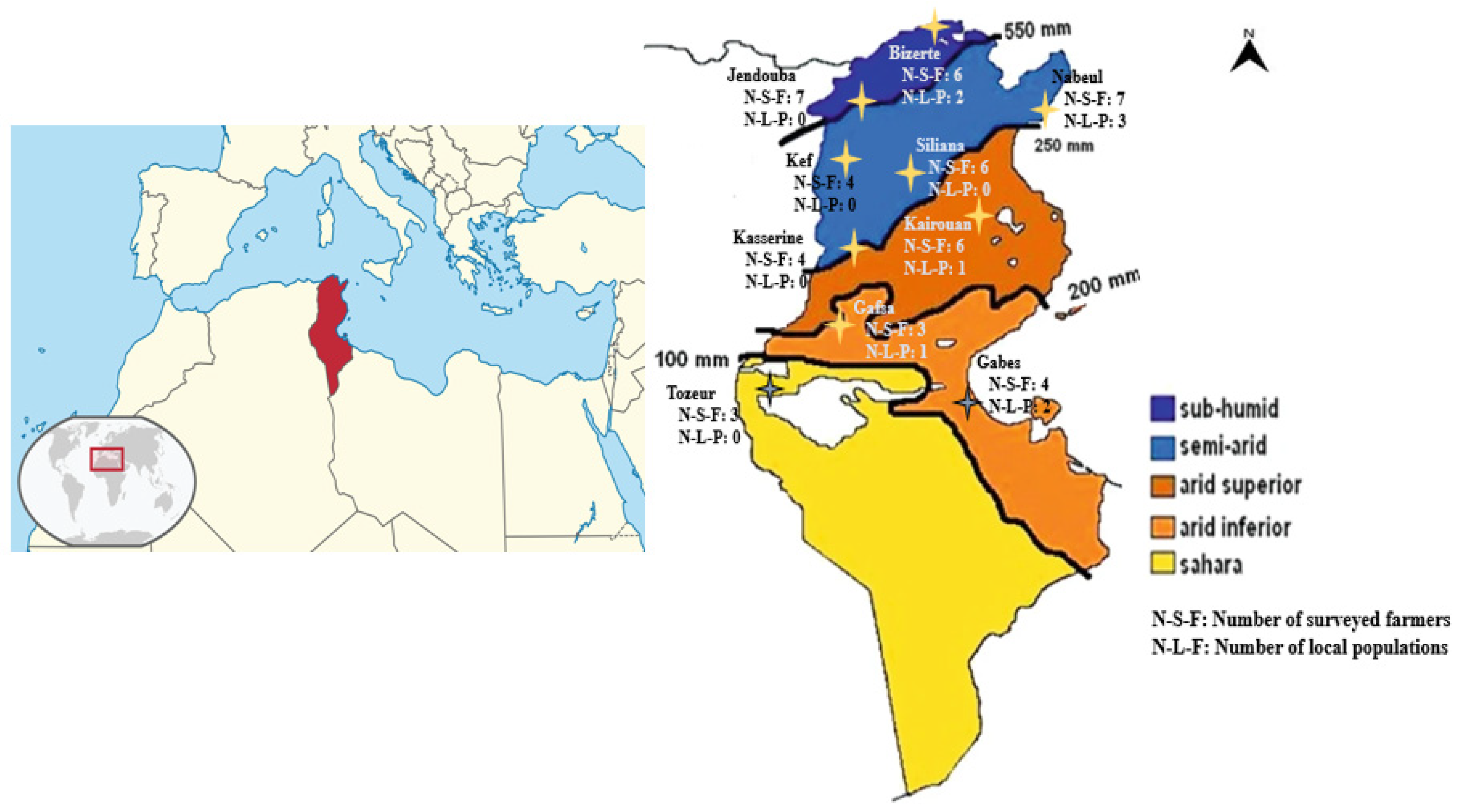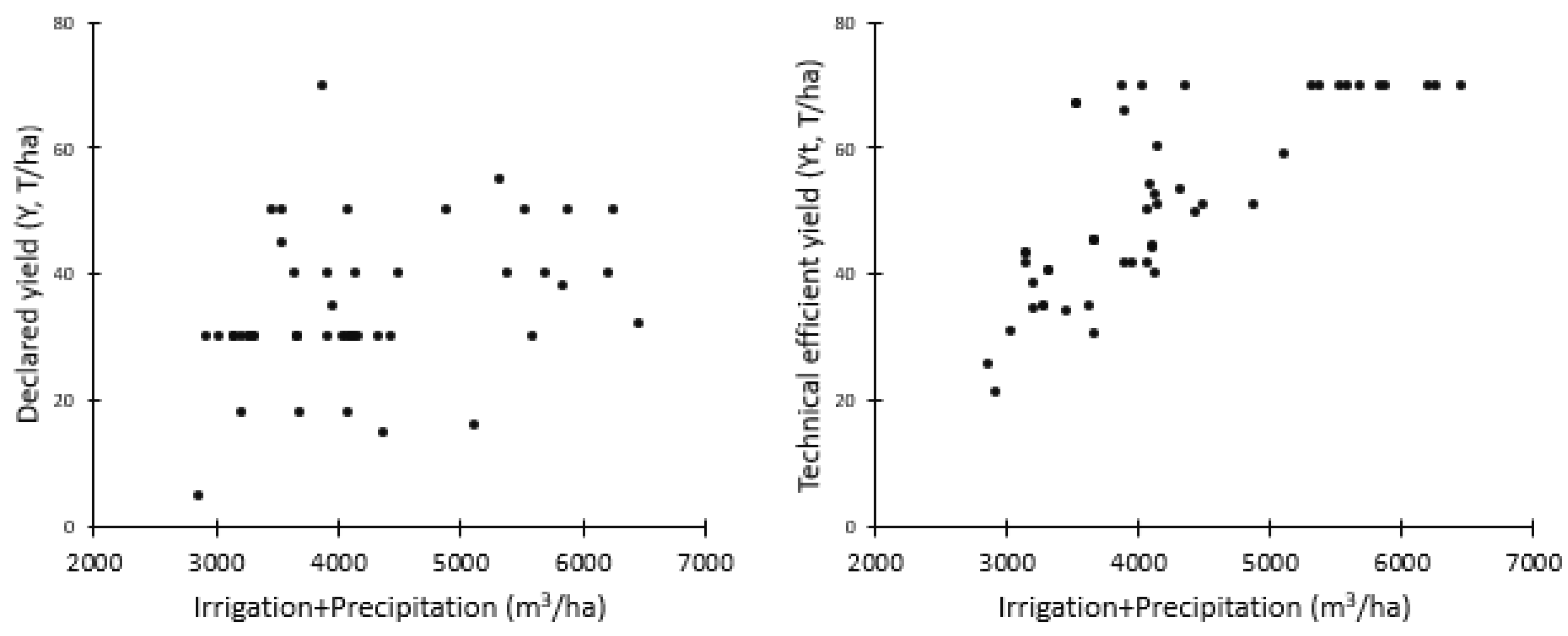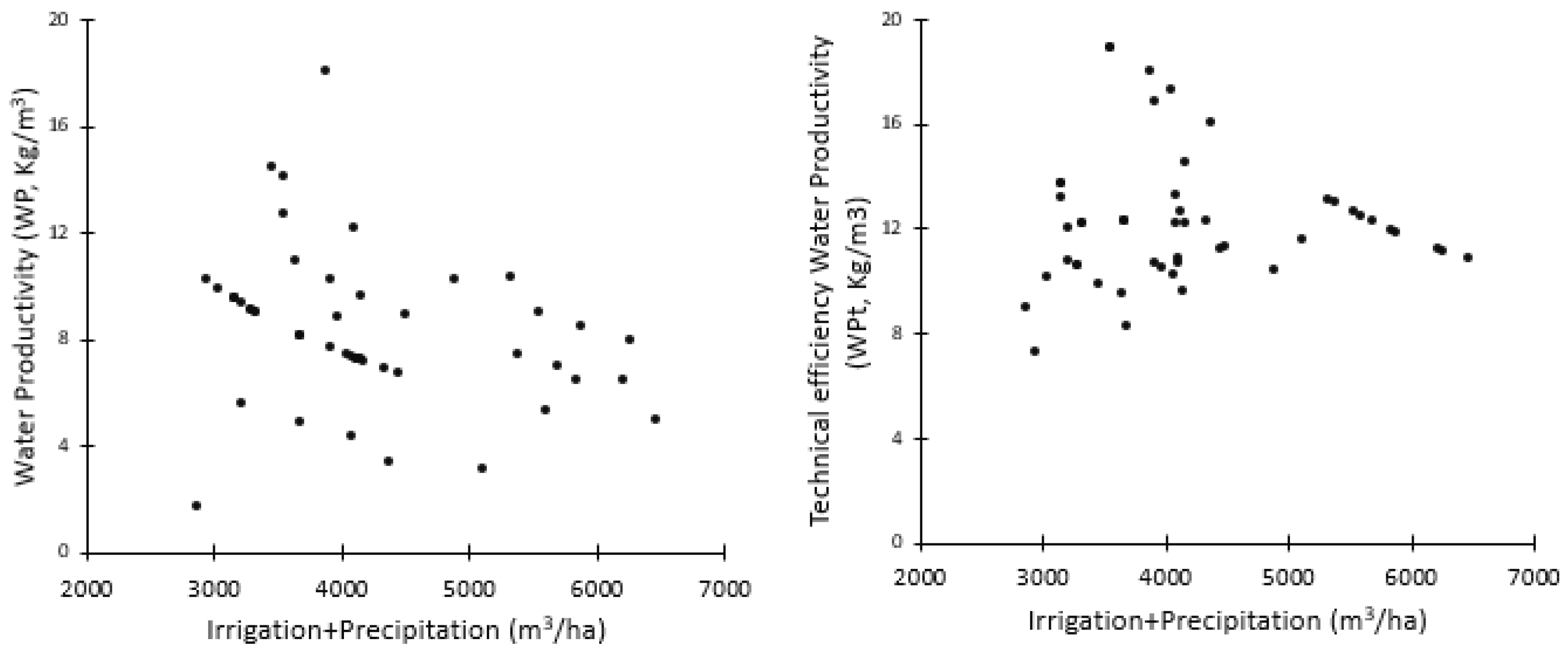Assessing Yield and Productivity Gaps in Tunisian Maize Cropping System
Abstract
1. Introduction
2. Materials and Methods
2.1. Data Collection and Estimations
2.1.1. Data Survey
2.1.2. Evapotranspiration Estimations
2.1.3. Yield and Yield Gap Estimations
2.1.4. Water Productivity and Water Productivity Gap Estimations
2.2. Tobit Regression
3. Results
3.1. Descriptive Analysis
3.2. Yield Levels and Gaps
3.3. Water Productivity Levels and Gaps
3.4. Tobit Analysis
4. Discussion
5. Conclusions
Author Contributions
Funding
Data Availability Statement
Conflicts of Interest
References
- Al-Salman, Y.; Ghannoum, O.; Cano, F.J. Elevated [CO2] negatively impacts C4 photosynthesis under heat and water stress without penalizing biomass. J. Exp. Bot. 2023, 74, 2875–2890. [Google Scholar] [CrossRef] [PubMed]
- FAOStat. FAO Stat. FAO, Rome. 2024. Available online: http://www.fao.org/faostat (accessed on 24 July 2024).
- DGEDA. Statistical Annal 2022. Tunisian Ministry of Agriculture, Water Resources and Fisheries. General Directorate for Agricultural Studies and Development. 2024. Available online: http://www.onagri.nat.tn/uploads/Etudes/Annuaire-Statistique-2022.pdf (accessed on 20 July 2024).
- Benabdelkader, M.; Saifi, R.; Saifi, H. Sustainable Agriculture in Some Arab Maghreb Countries (Morocco, Algeria, Tunisia). In Agro-Environmental Sustainability in MENA Regions; Abu-hashim, M., Khebour Allouche, F., Negm, A., Eds.; Springer International Publishing: Cham, Switzerland, 2021; pp. 233–261. [Google Scholar] [CrossRef]
- Davis, K.F.; Rulli, M.C.; Garrassino, F.; Chiarelli, D.; Seveso, A.; D’Odorico, P. Water limits to closing yield gaps. Adv. Water Resour. 2017, 99, 67–75. [Google Scholar] [CrossRef]
- Romdhane, L.; Radhouane, L.; Farooq, M.; Dal Cortivo, C.; Panozzo, A.; Vamerali, T. Morphological and biochemical changes in maize under drought and salinity stresses in a semi-arid environment. Plant Biosyst. 2020, 154, 396–404. [Google Scholar] [CrossRef]
- Shi, W.; Tao, F. Vulnerability of African maize yield to climate change and variability during 1961–2010. Food Sec. 2014, 6, 471–481. [Google Scholar] [CrossRef]
- Begna, T. Major Challenging Constraints to Crop Production Farming System and Possible Breeding to Overcome the Constraints. Int. J. Res. Stud. Agric. Sci. 2020, 6, 2454–6224. [Google Scholar]
- Piscitelli, L.; Colovic, M.; Aly, A.; Hamze, M.; Todorovic, M.; Cantore, V.; Albrizio, R. Adaptive Agricultural Strategies for Facing Water Deficit in Sweet Maize Production: A Case Study of a Semi-Arid Mediterranean Region. Water 2021, 13, 3285. [Google Scholar] [CrossRef]
- van Dijk, M.; Morley, T.; Jongeneel, R.; van Ittersum, M.; Reidsma, P.; Ruben, R. Disentangling agronomic and economic yield gaps: An integrated framework and application. Agric. Syst. 2017, 154, 90–99. [Google Scholar] [CrossRef]
- Wangmo, P.; Thinley, K.; Nakashima, T.; Kato, Y. Agronomic assessment of the yield variability and yield gap of maize in Bhutan. Crop Environ. 2024, 3, 25–32. [Google Scholar] [CrossRef]
- van Ittersum, M.K.; Cassman, K.G.; Grassini, P.; Wolf, J.; Tittonell, P.; Hochman, Z. Yield gap analysis with local to global relevance—A review. Field Crops Res. 2013, 143, 4–17. [Google Scholar] [CrossRef]
- Winans, E.T.; Beyrer, T.A.; Below, F.E. Managing Density Stress to Close the Maize Yield Gap. Front. Plant Sci. 2021, 12, 767465. Available online: https://www.frontiersin.org/journals/plant-science/articles/10.3389/fpls.2021.767465/full (accessed on 29 March 2023). [CrossRef]
- Rockström, J.; Falkenmark, M. Semiarid Crop Production from a Hydrological Perspective: Gap between Potential and Actual Yields. Crit. Rev. Plant Sci. 2000, 19, 319–346. [Google Scholar] [CrossRef]
- Tittonell, P.; Giller, K.E. When yield gaps are poverty traps: The paradigm of ecological intensification in African smallholder agriculture. Field Crops Res. 2013, 143, 76–90. [Google Scholar] [CrossRef]
- Fischer, T.; Byerlee, D.; Edmeades, G. Crop Yields and Global Food Security: Will Yield Increase Continue to Feed the World? ACIAR Monograph Series; ACIAR: Canberra, Australia, 2014; 634p.
- Lobell, D.B.; Cassman, K.G.; Field, C.B. Crop Yield Gaps: Their Importance, Magnitudes, and Causes. Annu. Rev. Environ. Resour. 2009, 34, 179–204. [Google Scholar] [CrossRef]
- Montoriol Garriga, J. The Use of Water in Agriculture: Making Progress in Modernising Irrigation and Efficient Water Management. 2022. Available online: https://www.caixabankresearch.com/en/node/10600/printable/print (accessed on 24 July 2024).
- Zwart, S.J.; Bastiaanssen, W.G.M. Review of measured crop water productivity values for irrigated wheat, rice, cotton and maize. Agric. Water Manag. 2004, 69, 115–133. [Google Scholar] [CrossRef]
- Cheng, M.; Yin, D.; Wu, W.; Cui, N.; Nie, C.; Shi, L.; Liu, S.; Yu, X.; Bai, Y.; Liu, Y.; et al. A review of remote sensing estimation of crop water productivity: Definition, methodology, scale, and evaluation. Int. J. Remote Sens. 2023, 44, 5033–5068. [Google Scholar] [CrossRef]
- Zheng, H.; Bian, Q.; Yin, Y.; Ying, H.; Yang, Q.; Cui, Z. Closing water productivity gaps to achieve food and water security for a global maize supply. Sci. Rep. 2018, 8, 14762. [Google Scholar] [CrossRef] [PubMed]
- Anghileri, D.; Chibarabada, T.P.; Gadedjisso-Tossou, A.; Craig, A.; Li, C.; Lu, Y.; Chimimba, E.G.; Kambombe, O.; Musa, F.; Ngongondo, C.; et al. Understanding the maize yield gap in Southern Malawi by integrating ground and remote-sensing data, models, and household surveys. Agric. Syst. 2024, 218, 103962. [Google Scholar] [CrossRef]
- Omotoso, A.B.; Letsoalo, S.S.; Daud, S.A.; Tshwene, C.; Omotayo, A.O. Climate-smart agricultural practices, productivity, and food-nutrition security in rural South Africa: A dataset of smallholder maize farmers. Data Brief. 2024, 55, 110725. [Google Scholar] [CrossRef] [PubMed]
- Allen, R.; Pereira, L.; Smith, M. Crop Evapotranspiration-Guidelines for Computing Crop Water Requirements-FAO Irrigation and Drainage Paper 56; FAO: Roma, Italy, 1998; Volume 56. [Google Scholar]
- Doorenbos, J.; Kasssam, A.H. Yield response to Water. In FAO Irrigation and Drainage Paper No 33; FAO: Rome, Italy, 1979. [Google Scholar]
- Molden, D.; Oweis, T.; Steduto, P.; Bindraban, P.; Hanjra, M.A.; Kijne, J. Improving agricultural water productivity: Between optimism and caution. Agric. Water Manag. 2010, 97, 528–535. [Google Scholar] [CrossRef]
- Amemiya, T. Tobit models: A survey. J. Econom. 1984, 24, 3–61. [Google Scholar] [CrossRef]
- Tobin, J. Estimation of Relationships for Limited Dependent Variables. Econom. J. Econom. Soc. 1958, 26, 24–36. [Google Scholar] [CrossRef]
- Yee, T.W. Vector Generalized Linear and Additive Models: With an Implementation in R; Springer Series in Statistics; Springer: New York, NY, USA, 2015; Available online: https://link.springer.com/10.1007/978-1-4939-2818-7 (accessed on 26 August 2024).
- Waqas, M.A.; Wang, X.; Zafar, S.A.; Noor, M.A.; Hussain, H.A.; Azher Nawaz, M.; Farooq, M. Thermal Stresses in Maize: Effects and Management Strategies. Plants 2021, 10, 293. [Google Scholar] [CrossRef] [PubMed]
- Cirilo, A.G.; Andrade, F.H. Sowing Date and Maize Productivity: II. Kernel Number Determination. Crop Sci. 1994, 34, 1044–1046. [Google Scholar] [CrossRef]
- Lasram, A.; Dellagi, H.; Dessalegn, B.; Dhehibi, B.; Ben Mechlia, N. Farmers’ willingness to adapt to climate change for sustainable water resources management: A case study of Tunisia. J. Water Clim. Change 2018, 9, 598–610. [Google Scholar] [CrossRef]
- Gaaloul, N. Water resources and management in Tunisia. Int. J. Water 2011, 6, 92. [Google Scholar] [CrossRef]
- Chemak, F.; Boussemart, J.; Jacquet, F. Farming system performance and water use efficiency in the Tunisian semi-arid region: Data envelopment analysis approach. Int. Trans. Oper. Res. 2010, 17, 381–396. [Google Scholar] [CrossRef]
- Husson, O.; Hanhart, K.; Phung, M.T.; Bouma, J. Water management for rice cultivation on acid sulphate soils in the Plain of Reeds, Vietnam. Agric. Water Manag. 2000, 46, 91–109. [Google Scholar] [CrossRef]
- Valentín, F.; Nortes, P.A.; Domínguez, A.; Sánchez, J.M.; Intrigliolo, D.S.; Alarcón, J.J.; López-Urrea, R. Comparing evapotranspiration and yield performance of maize under sprinkler, superficial and subsurface drip irrigation in a semi-arid environment. Irrig. Sci. 2020, 38, 105–115. [Google Scholar] [CrossRef]
- Nandwani, D. (Ed.) Organic Farming for Sustainable Agriculture; Sustainable Development and Biodiversity; Springer International Publishing: Cham, Switzerland, 2016; Volume 9, Available online: http://link.springer.com/10.1007/978-3-319-26803-3 (accessed on 25 March 2024).
- Gao, S.; Ming, B.; Liu, G.Z.; Zhang, G.Q.; Li, Y.Y.; Xue, J.; Wang, K.; Zhou, S.-L.; Xie, R.-Z.; Li, S.-K. Increasing plant density improved maize yield without penalty of harvest grain moisture in extensive field trials. Ann. Agric. Sci. 2024, 69, 33–43. [Google Scholar] [CrossRef]
- Nyirenda, H.; Mwangomba, W.; Nyirenda, E.M. Delving into possible missing links for attainment of food security in Central Malawi: Farmers’ perceptions and long term dynamics in maize (Zea mays L.) production. Heliyon 2021, 7, e07130. [Google Scholar] [CrossRef] [PubMed]
- Assefa, B.T.; Chamberlin, J.; Reidsma, P.; Silva, J.V.; van Ittersum, M.K. Unravelling the variability and causes of smallholder maize yield gaps in Ethiopia. Food Sec. 2020, 12, 83–103. [Google Scholar] [CrossRef]
- Liu, X.; Wang, X.; Wang, X.; Gao, J.; Luo, N.; Meng, Q.; Wang, P. Dissecting the critical stage in the response of maize kernel set to individual and combined drought and heat stress around flowering. Environ. Exp. Bot. 2020, 179, 104213. [Google Scholar] [CrossRef]
- Ojeniyi, K.; Ngonidzashe, C.; Devkota, K.; Madukwe, D. Optimizing split-fertilizer applications for enhanced maize yield and nutrient use efficiency in Nigeria’s Middle-belt. Heliyon 2024, 10, e37747. [Google Scholar] [CrossRef]
- Mezgebo, G.K.; Mekonen, D.G.; Gebrezgiabher, K.T. Do smallholder farmers ensure resource use efficiency in developing countries? Technical efficiency of sesame production in Western Tigrai, Ethiopia. Heliyon 2021, 7, e07315. [Google Scholar] [CrossRef] [PubMed]
- Chemak, F.; Mazhoud, H.; Rached, Z.; Gara, A.; Rahmeni, R.; Ghannem, H. Measuring Technical Efficiency for Closing Yield Gap and Improving Water Productivity of the Irrigated Durum Wheat in Tunisia. Water 2022, 14, 2270. [Google Scholar] [CrossRef]
- Tamene, L.; Mponela, P.; Ndengu, G.; Kihara, J. Assessment of maize yield gap and major determinant factors between smallholder farmers in the Dedza district of Malawi. Nutr. Cycl. Agroecosyst. 2016, 105, 291–308. [Google Scholar] [CrossRef]
- MacCarthy, D.S.; Adiku, S.G.K.; Freduah, B.S.; Gbefo, F.; Kamara, A.Y. Using CERES-Maize and ENSO as Decision Support Tools to Evaluate Climate-Sensitive Farm Management Practices for Maize Production in the Northern Regions of Ghana. Front. Plant Sci. 2017, 8, 31. Available online: https://www.frontiersin.org/journals/plant-science/articles/10.3389/fpls.2017.00031/full (accessed on 24 July 2024). [CrossRef]
- van Loon, M.P.; Adjei-Nsiah, S.; Descheemaeker, K.; Akotsen-Mensah, C.; van Dijk, M.; Morley, T.; van Ittersum, M.K.; Reidsma, P. Can yield variability be explained? Integrated assessment of maize yield gaps across smallholders in Ghana. Field Crops Res. 2019, 236, 132–144. [Google Scholar] [CrossRef]
- Wang, H.; Ren, H.; Zhang, L.; Zhao, Y.; Liu, Y.; He, Q.; Li, G.; Han, K.; Zhang, J.; Zhao, B.; et al. A sustainable approach to narrowing the summer maize yield gap experienced by smallholders in the North China Plain. Agric. Syst. 2023, 204, 103541. [Google Scholar] [CrossRef]



| Variables | Mean | Min | Max |
|---|---|---|---|
| Age (year) | 52.6 | 28 | 75 |
| Total cropping area (ha) | 44.5 | 2 | 630 |
| Maize area (ha) | 3.6 | 1 | 20 |
| Sowing rate (kg/ha) | 26.6 | 10 | 30 |
| Irrigation (m3/ha) | 3660 | 2500 | 6000 |
| DAP (kg/ha) | 153 | 100 | 300 |
| Manure (T/ha) | 14 | 0 | 40 |
| Ammonium (kg/ha) | 200 | 100 | 550 |
| Declared average yield of green fodder biomass (T/ha) | 34.3 | 10 | 70 |
| Water productivity (kg/m3) | 8.4 | 3.5 | 18.1 |
| Variables | Categories | Farmers (%) |
|---|---|---|
| Education | Primary | 24 |
| Secondary | 32 | |
| Higher | 44 | |
| Sowing Date | April | 24 |
| Mai | 16 | |
| Jun | 24 | |
| July | 18 | |
| August | 14 | |
| September | 4 | |
| Previous Crop | Cereals | 70 |
| Legumes | 18 | |
| Horticultural crops | 12 | |
| Irrigation system | Drip | 30 |
| Sprinkler | 54 | |
| Submersion | 16 | |
| Final utilization | Trading | 10 |
| Self-consumption | 54 | |
| Self-consumption + trading | 36 |
| Variables | Categories | Average Green Fodder Biomass (T/ha) | Standard Deviation (T/ha) |
|---|---|---|---|
| Type of seeds | Hybrid | 38.0 | 11.7 |
| Local | 28.5 | 8.1 | |
| Area | North | 36.9 | 14.3 |
| Center | 33.5 | 8.7 | |
| South | 30.6 | 5.3 | |
| Irrigation System | Drip | 39.3 | 13.1 |
| Sprinkler | 32.4 | 11.7 | |
| Submersion | 31.5 | 3.5 |
| Technical Efficiency | Coefficient | Standard Error | p-Value |
|---|---|---|---|
| Diammonium Phosphate dose (DAP) (kg/ha) | 0.000735 | 0. 000316 | 0.025 * |
| Ammonium dose (kg/ha) | 0.000541 | 0.000226 | 0.021 * |
| Sowing rate (kg/ha) | 0.020889 | 0.005408 | 0.000 ** |
| Type of variety (Hybrid/Local) | 0.143568 | 0.057421 | 0.017 * |
| Region (Center/North) | 0.153858 | 0.056177 | 0.009 ** |
| Region (south/North) | 0.284737 | 0.078409 | 0.001 ** |
| Cultivated Area (ha) | 0.005683 | 0.005090 | 0.271 |
| Education level (Secondary/Primary) | 0.007632 | 0.064847 | 0.907 |
| Education level (Bachelor’s/Primary) | −0.074466 | 0.069895 | 0.293 |
| _cons | −0.266600 | 0.159836 | 0.103 |
| Censoring Parameter (/sigma) | 0.143137 | 0.0151481 |
Disclaimer/Publisher’s Note: The statements, opinions and data contained in all publications are solely those of the individual author(s) and contributor(s) and not of MDPI and/or the editor(s). MDPI and/or the editor(s) disclaim responsibility for any injury to people or property resulting from any ideas, methods, instructions or products referred to in the content. |
© 2025 by the authors. Licensee MDPI, Basel, Switzerland. This article is an open access article distributed under the terms and conditions of the Creative Commons Attribution (CC BY) license (https://creativecommons.org/licenses/by/4.0/).
Share and Cite
Hammami, M.D.E.; Lasram, A.; Kthiri, Z.; Boukef, S.; Hamada, W.; Revilla, P.; Karmous, C. Assessing Yield and Productivity Gaps in Tunisian Maize Cropping System. Agronomy 2025, 15, 331. https://doi.org/10.3390/agronomy15020331
Hammami MDE, Lasram A, Kthiri Z, Boukef S, Hamada W, Revilla P, Karmous C. Assessing Yield and Productivity Gaps in Tunisian Maize Cropping System. Agronomy. 2025; 15(2):331. https://doi.org/10.3390/agronomy15020331
Chicago/Turabian StyleHammami, Mohamed Dhia Eddine, Asma Lasram, Zayneb Kthiri, Sameh Boukef, Walid Hamada, Pedro Revilla, and Chahine Karmous. 2025. "Assessing Yield and Productivity Gaps in Tunisian Maize Cropping System" Agronomy 15, no. 2: 331. https://doi.org/10.3390/agronomy15020331
APA StyleHammami, M. D. E., Lasram, A., Kthiri, Z., Boukef, S., Hamada, W., Revilla, P., & Karmous, C. (2025). Assessing Yield and Productivity Gaps in Tunisian Maize Cropping System. Agronomy, 15(2), 331. https://doi.org/10.3390/agronomy15020331






